In cooler seasons and climates, layers are essential for comfort. It’s not just about insulation. Moisture-wicking fabrics help keep skin dry, which is just as important to staying warm as wearing a thick jacket. Fleece jackets provide that balance of warmth and breathability for hiking and backpacking.
Invented in the late 70s, fleece was the first synthetic technical fabric. Fleece jackets are versatile hiking gear because they can be worn as a jacket or as a mid layer. In many cold conditions, a base layer, fleece jacket, and a hardshell jacket are all you need.
Fleece fabrics are not all created equal. Some brands include spandex for a closer fit and full mobility. Others use some nylon to provide extra durability. Fleece is a petroleum product but instead of using virgin oil, most modern fleece uses some or all recycled plastic.
The number and type of fleece jackets and hoodies available can be overwhelming. So, where does one begin? Here are our top picks and a quick guide to features to consider when buying a fleece jacket. Keep reading if you’re looking for kids’ fleece too.
Some brands will show up more than once. Patagonia literally invented fleece with the North Face not too far behind. They keep making their best products and working on new innovations.
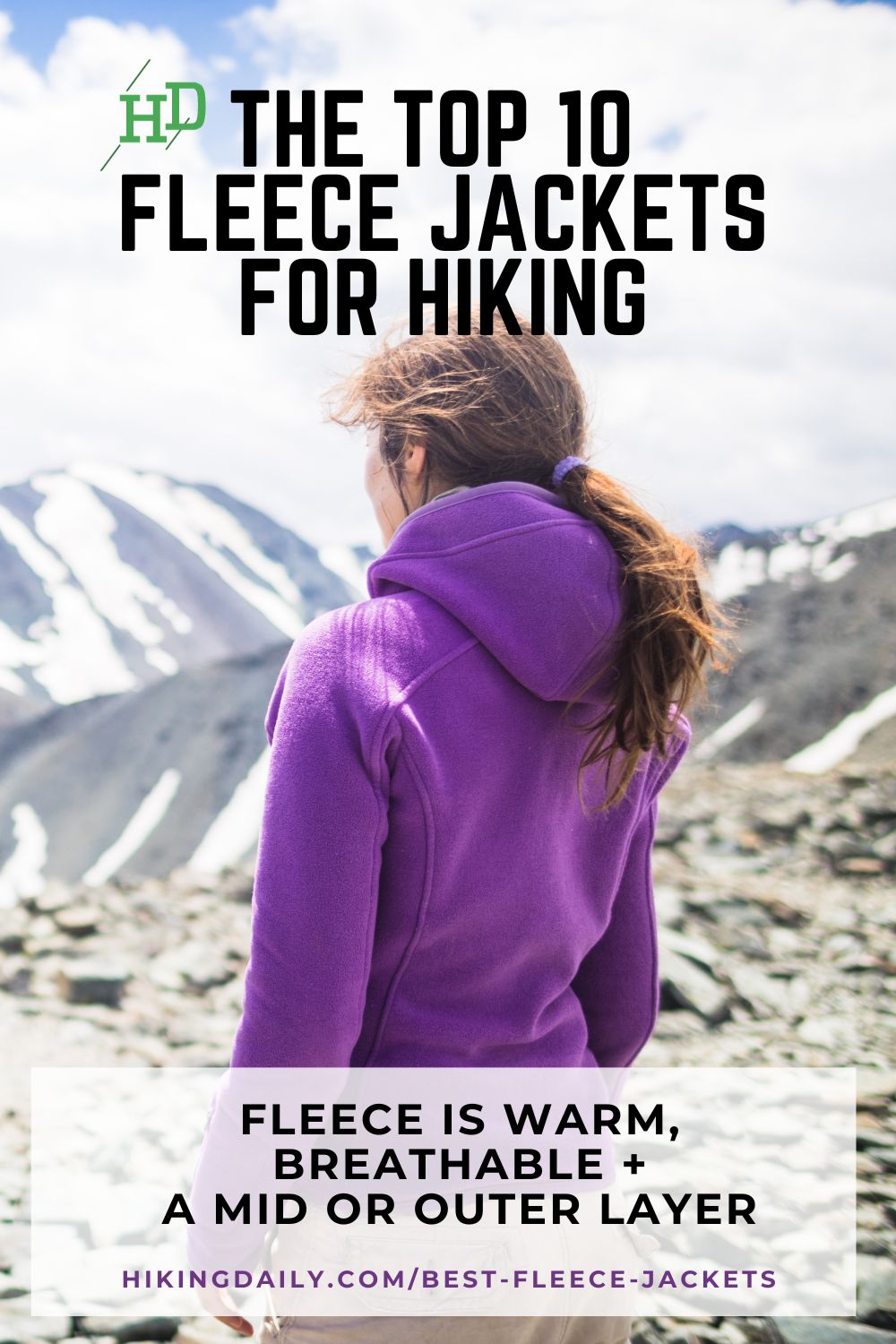
1. Insulation, Warmth + Heat Retention
Many fleece jackets do not provide as much warmth as you may be led to think. It is very important to examine the technical specifications of a jacket. Some jackets advertise grams/m² which indicates the general weight (heavy vs lightweight) of the fleece. A windproof or wind-resistant fleece jacket will be warmer.
The Polartec scale refers to the weight, loft, and and warmth of the fabric.
- <100 Ultralight – Thinnest, most breathable
- 100+ Lightweight – Thin, highly breathable
- 200+ Medium Weight – Balance of warmth and breathability
- 300+ Heavy Weight – Thick and high loft, warmest, somewhat windproof and breathable.
Grid Fleece
Technical fleece is designed to balance heat retention and breathability. Breathability refers to the transfer of moisture from inside the fabric to the outside.
On the outside, the fleece is smooth. All the magic happens on the inside.
An inner checkerboard pattern of fabric creates air pockets that trap warm air and wick away moisture. The thinner fabric in between the squares allows sweat to evaporate and vent to the outside.
This is what you want to wear for aerobic activities in the cold. The breathability is essential to maintaining warmth. That breathability works both ways, meaning it is the opposite of windproof so keep another layer on hand.
2. Breathability + Moisture Wicking + Thermal Efficiency
Generally speaking, thicker heavier fleece will not breathe as well as lighter fleece layers. Conversely, heavier fleece retains more heat and can be an outer layer in colder conditions than thinner fleece.
A breathable fabric prevents overheating as well as getting cold from a damp jacket.
Lightweight fleece is highly breathable, wicks moisture quickly, and has some stretch for a close fit and full range of movement. They work best for physical activities in moderate weather or as a mid-layer for colder conditions.
Mid-weight fleece is the most versatile. It works well as a jacket for a range of cool temperatures but can also be worn with additional layers above or below. Some mid-weight fleece is more breathable for high energy activities while others have a denser knit to be worn as an outer layer.
Heavyweight fleece jackets do one thing best – keep you warm. The thicker fabric keeps in heat and block most wind, working best as a stand-alone piece for cool weather. Thick fleece doesn’t breathe very well so is better for low impact activities.
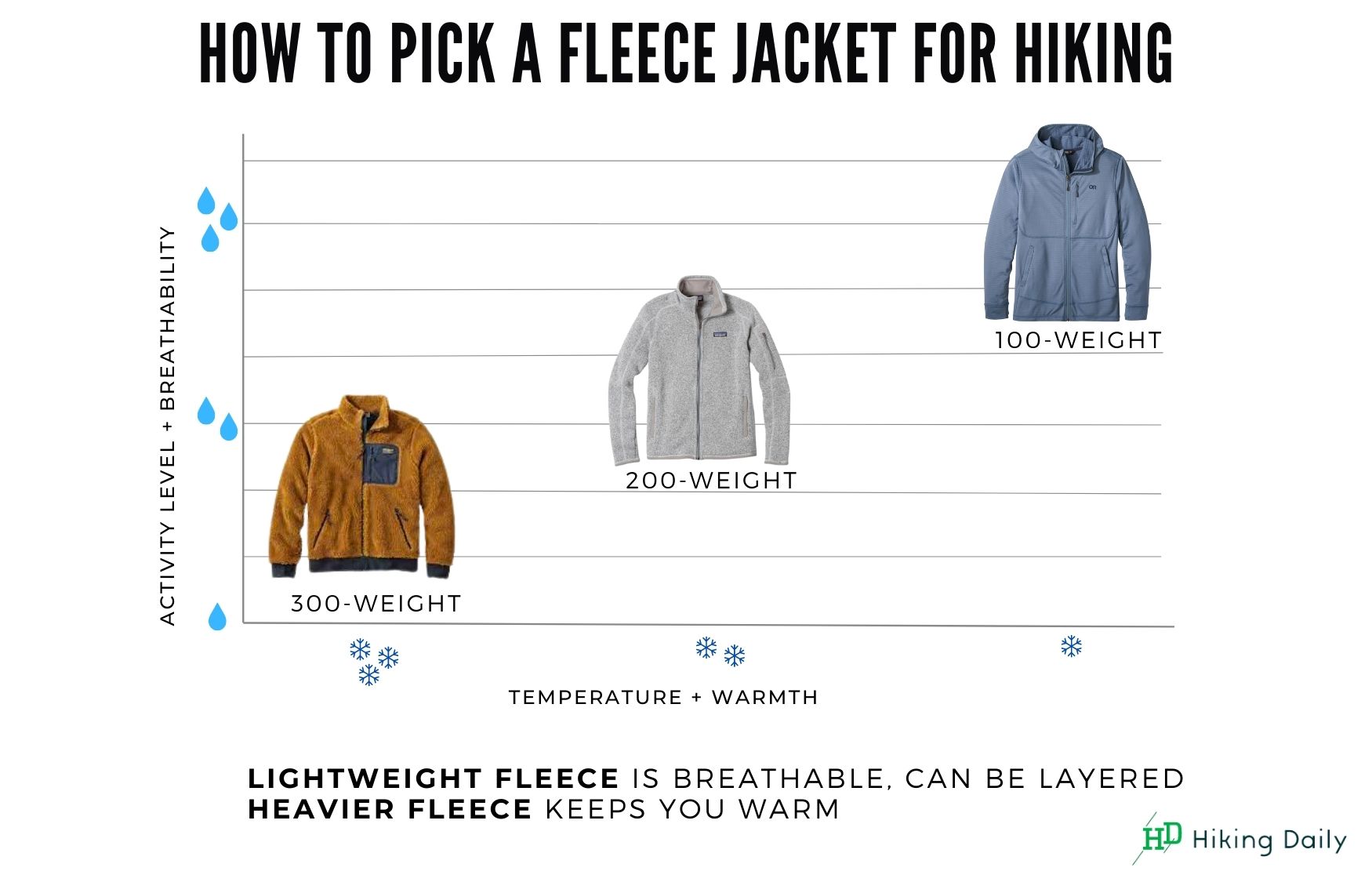
3. Zipper Length
Zippers provide another way to manage heat and breathability in a jacket. Fleece jackets are usually available with 1/4, 1/2, or full length zippers. Full length zippers provide the most functionality and are recommended here.
High winds can find their way through zipper areas. Look for a fleece jacket that has wind flaps to keep the wind out and to stay warm
4. Fit
The best fit for a fleece jacket depends on the use. Performance fleece jackets are usually slim cut to be worn with multiple layers on top. Heavier fleece jackets may be too bulky to add anything over but can be worn with more layers below. Mid-weight fleeces can do both.
5. Mobility
Mobility is a very important feature for hikers or backpackers that are carrying a backpack or who move quickly on the trails. Look for articulated patterning and gusseted underarms for extra mobility. A gusset is a diamond- or triangle–shaped insert in a seam. When placed in the armpit, it adds some room to the upper arm and chest and relieves strain on those areas.
Another factor is the overall fit. Fleeces that are a wider fit or heavier in weight can reduce overall mobility when worn under a hardshell jacket. We recommend a trim fit that falls at the hip in length. You might want to order a couple of options and compare how they feel and just return what is less comfortable. A small percentage of spandex will also increase mobility.
6. Collar vs Hoodie
A collared fleece jacket is a bit more comfortable and easier to layer underneath other jackets. A hooded fleece jacket (aka fleece hoodie) is a good option for extra warmth, especially for those times you forget a warm hat. Some of our top picks are available in both styles.
7. Pockets
Most jackets will have hand pockets to keep warm. Others will include chest or arm pockets which are handy to stash things like phones or keys. Most pockets will have zippers but not all.
Lightweight fleece often have mesh pockets for a flat fit without extra weight. Heavier fleece often have fleece-lined pockets for extra warmth and comfort.
8. Thumbholes
Some people like thumbholes or thumb loops to keep sleeves from bunching up and to keep the wrists fully covered. Thumbholes are handy when taking off or putting on layers.
9. Water Resistance
Fleece is hydrophobic, meaning it will shed water. This is not the same as being waterproof but it does dry quickly.
More breathable fleece is less resistant to wind and water than thicker, denser knits. Some fleece jackets add a coating of Durable Water-Repellant for additional water protection but a fleece will not replace a rain jacket or hard shell.
10. Windproof or Wind-Resistance
Fleece jackets are not really known to be windproof, and perhaps quite the opposite in most cases. This is why you should always carry a lightweight windproof and waterproof jacket in your hiking daypack. However, some do offer wind resistance or windproofing.
Elastic hem and cuffs to keep warmth in and elements out. Some boxier styles may have a drawstring cord.
The Best Fleece Jackets
Okay, now that we know all about the features, let’s now take a look at our top picks! Each jacket is awesome for its own reason or purpose.
The Best Fleece Jackets
1. Most Versatile Fleece – Patagonia R1 Daily Jacket
2. All-Around Best Fleece Jacket – Arc’teryx Kyanite
3. The Best Fleece For Most People – The North Face Canyonlands
4. Most Breathable Fleece – Patagonia R1 Air Hoodie
5. The Lightest Weight Fleece – The North Face Summit Futurefleece
6. Best Quarter Zip Fleece – Outdoor Research Trail Mix Pullover
7. Best Technical Fleece With A Regular Fit – REI Co-op Hyperaxis Fleece Jacket 2.0
8. Best Value Fleece Jacket – Columbia Benton Springs (W) + Steens Mountain (M) Fleece
9. Best Fleece Jacket For Trail + Town – Patagonia Better Sweater
10. Warmest Performance Fleece – KUHL Ascendyr (W) + KUHL Interceptr (M)
1. Most Versatile Fleece
Patagonia R1 Daily Jacket
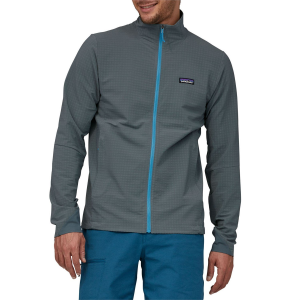
The Regulator 1 (R1) fleece fabric was released in 1990 and continues to excel in warmth and breathability for high-intensity cold-weather activities. There are also R1 Air and R2 fabrics but this is our top pick because it is useful in the widest range of conditions.
MSRP $139
Warmth Warm
Weight 9.7-11.7 ounces
Fabric 93% recycled polyester/7% spandex
Fit Fitted
What We Like Stretchy, lightweight, very breathable, some wind resistance, odor control
What We Don’t Like Nothing but this level of breathability may not be required for all hikers
A lightweight fleece is more versatile than heavier versions. R1 fleece is thin enough to be a base layer but also warm enough to function as a mid or outer layer. I reach for mine on misty mornings, cool summer nights, and to keep warm when snow is on the ground. I prefer a collar to a hood for layering.
The outer layer is fairly abrasion resistant while the inside is soft enough to wear over a t-shirt. The structured cut and fit is comfortable for a range of activities and looks great everywhere.
2. All-Around Best Fleece Jacket
Arc’teryx Kyanite
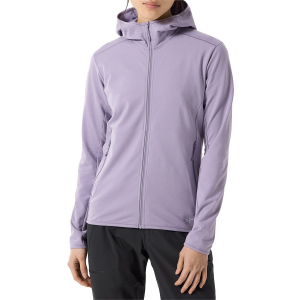
Arc’teryx has a reputation for high quality and high prices. The Kyanite fleece offers the former without the latter.
MSRP $179.00
Warmth Warmer
Weight 12.1-14.6 oz
Fabric Polartec Power Stretch Pro polyester (53% polyester/38% nylon/9% elastane)
Fit Fitted
What We Like Flattering cut + seams, cozy softness, XXS-XXL
What We Don’t Like May need to size up due to close fit
The best way to describe this fleece is luxurious, with an ultra soft interior that feels much warmer than the weight. The nylon content helps resist abrasion and blocks some wind.
Most fleece jackets have a boxy fit but the Kyanite manages to avoid that. The articulated seams add structure and shape. The hem is also lower than many fleeces for more warmth and coverage.
Although this fleece uses the same fabric as the REI Co-op Hyperaxis, this design looks and feels better. The price is comparable with similar products but the quality is superior. Get it with an REI 20% off coupon and you come out ahead.
3. Best Fleece Jacket For Most People
The North Face Canyonlands Fleece

This fleece is the best quality for the bucks as well as available in a wide range of sizes.
MSRP $80-$100
Warmth Warmer (200)
Weight 11XX unces
Fabric 96% recycled polyester/4% elastane
Fit Standard
What We Like Some stretch, sizes up to 3X/XXL, classic style
What We Don’t Like Second logo on the back
For under $100, you get a good-looking mid-weight fleece that is equally at home on the the trails as it is on the sidewalk. The fabric is smooth on the outside to minimize pilling and brushed on the inside for softness and warmth. Choose from hooded, full zip, mid zip jackets, and more.
4. Most Breathable Fleece Jacket
Patagonia R1 Air Full-Zip Hoodie

The R1 Air fleece has a zig-zag texture to wick moisture and dry faster.
MSRP $169
Warmth Warm (178)
Weight 10.9-12.9 ounces
Fabric 100% recycled polyester jacquard fleece with hollow-core yarns
Fit Fitted
What We Like Excellent for high output activities
What We Don’t Like Textured exterior can snag
Depending on who you ask, the R1 Air is either much better or worse than the original R1. We’ll let you decide.
The fabric is more technical with texture designed to dump heat faster. On the flip side, there are less features like thumbholes or an adjustable collar. It depends on what works best for you.
This is a great choice for challenging routes, fast hikes, and people who run hot.
5. The Lightest Weight Fleece
The North Face Summit FutureFleece Hoodie

Lightweight doesn’t mean less warm. The FutureFleece grid structure maximizes the warmth-to-weight ratio and is also windproof.
MSRP $170
Warmth Warm (124 g/m2)
Weight 6.2-7.3 ounces
Fabric 55% polyester/45% recycled polyester
Fit Slim fit
What We Like Windproof, breathable, packable
What We Don’t Like Sleeves are short for some people
If size and weight matter the most, this is the fleece for you. It weighs less than half a pound but is as warm as jackets with double the weight. The fabric is thinner than most fleeces but also warmer than it feels like it should be.
The balance between breathability, warmth, and windproofing mean Futurefleece performs for high output activities and warm conditions as well as it keeps in heat.
Like other North Face fleece jackets, the Summit is stylish enough to wear in town as well as light enough to take anywhere, this is a versatile fleece that will get three season use or more.
6. Best 1/4 Zip Pullover Fleece
Outdoor Research Trail Mix Pullover
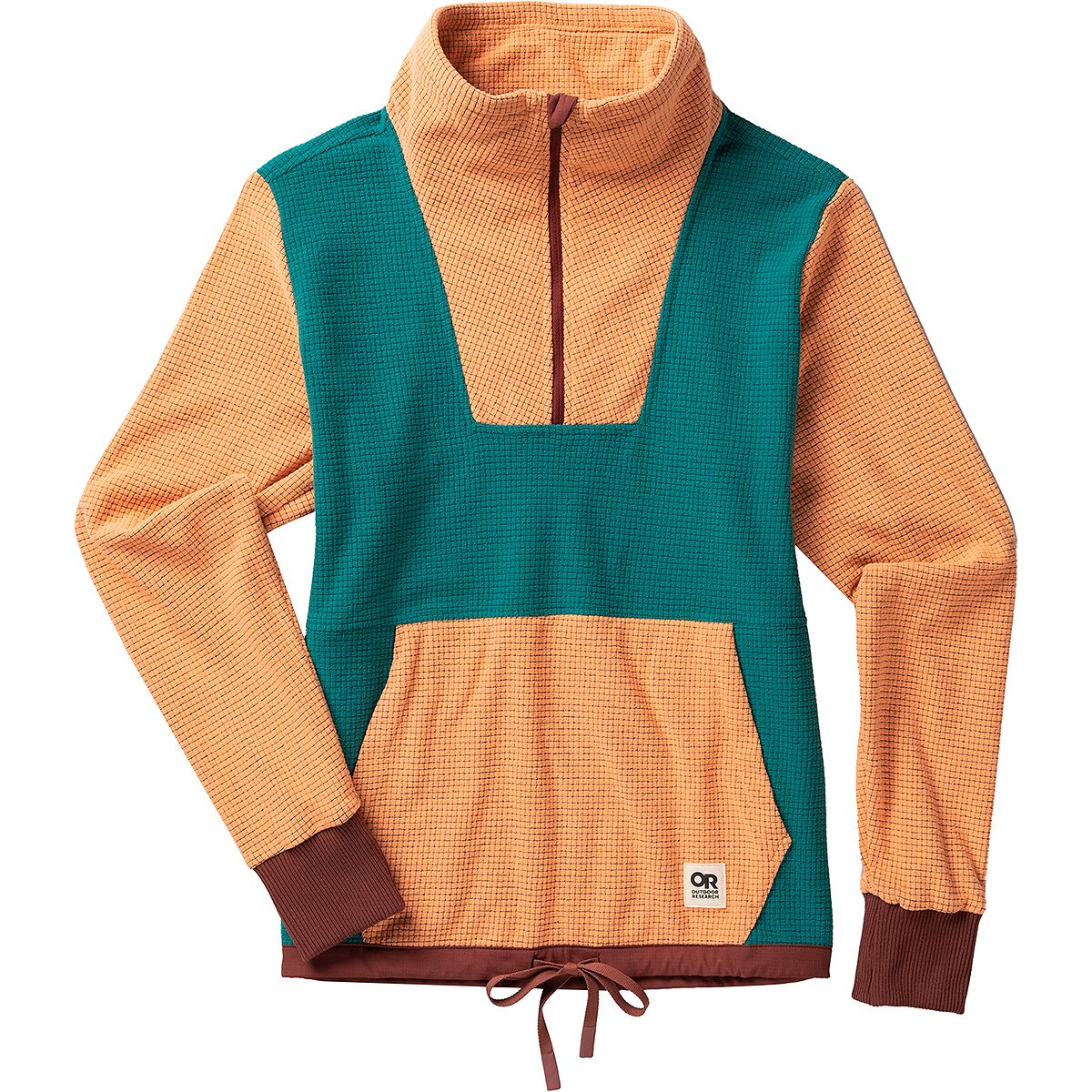
A quarter zipper plus kangaroo pocket brings some street style to this performance fabric.
MSRP $120
Warmth Warmer
Weight 12.5-13.3 ounces
Fabric Nylon blend (94% recycled)
Fit Regular
What We Like Kangaroo pocket, contrasting colors, rib cuffs, high neck
What We Don’t Like Tough to choose a style of Trail Mix fleece
I prefer full zip fleece for maximum temperature control but the Trail Mix fleece breathes and wicks moisture so well that I don’t need it. The snap pullover is also great but it is only available in women’s.
I don’t know how the grid fabric knows how to “maintain sufficient warmth or releases excess heat depending on your exertion level” but it is comfortable in cool mornings and as the day heats up.
A high neck, kangaroo pouch, and drop hem make this fleece extra cozy. The pocket also has mesh phone pouch to keep it from bouncing around. I also appreciate added water-resistance at the neck and shoulders.
7. Best Technical Fleece With A Regular Fit
REI Co-op Hyperaxis Fleece Jacket 2.0

Technical clothing is often technically tight. The Hyperaxis adds a little bit of room to the otherwise fitted fleece.
MSRP $139-$149
Warmth Warmer
Weight 14.2 ounces
Fabric Polartec Power Stretch Pro (bluesign approved)
Fit Fitted with some room to spare
What We Like Roomy fit, thumbholes, plus sizes
What We Don’t Like Pricy for REI Co-op Brand
You have to touch this fabric to appreciate the combination of soft and stretchy. In fact, it is the same material as the pricer Arc’teryx Kyanite fleece. The pattern design is very different between the two so try them both to see which one fits you better. This cut is looser than most technical fleece so size down if you’re going to use this as a mid layer.
REI’s technical fleece quality is on par with other outdoor brands but so is the price tag. Keep an eye out for 25% off Co-op brand sales to get a sweet deal. The original Hyperaxis is deeply discounted while supplies last.
8. Best Budget Fleece Jacket
Columbia Benton Springs (W) + Steens Mountain (M)

We talk a lot about the warmth-to-weight ratio but this fleece has the best warmth-to-cost ratio. If the names are honoring The Boss, even better.
MSRP $45-$58
Warmth Warmer (250)
Weight Not listed
Fabric 100% polyester MTR filament fleece
Fit Regular
What We Like Price, selection of sizes, colors, patterns, zippers + hoods
What We Don’t Like No elastic at cuffs or hem
At around $50, this is by far the cheapest fleece on the list. Just like expensive doesn’t mean high quality, affordable doesn’t mean low quality.
The fleece is nothing fancy but gets the job done. Two zipper side pockets keep the hands warm. The fit is loose but some versions have a waist draw cord to keep out wind.
There is a huge range of color choices for the popular fleece from a variety of stores so shop around to find one you love. It is also available in petite and plus sizes.
Women’s
Men’s
9. Warmest Performance Fleece
Men: KUHL Interceptr
The Interceptr looks like a classic fleece but has plenty of performance features.

MSRP $139
Warmth Warmer (305g + 210g side panels)
Weight 1 lb 3.2 oz
Fabric 78% acrylic/22% polyester + 70% acrylic/30% polyester sides
Fit Regular
What We Like Multiple fabrics, plenty of zipper pockets, pockets warm hands up
What We Don’t Like Heavy
The dual-fleece design maximizes warmth at the core with thinner side panels for added breathability and less weight. More fleece inside the collar and pockets protect the neck and keep hands warm.
The Interceptr looks good enough to wear anywhere and functions well enough for outdoor adventures. It’s available as a full zip, quarter zip, and vest.
Women: KUHL Ascendyr
Kuhl’s heavier weight fleece for women is heavier weight without being bulky and uses a two-way zipper to manage heat.

MSRP $109+
Warmth Warmest (480)
Weight 1 lb 3.2 oz
Fabric 100% melange-knit polyester fleece
Fit Regular but feminine
What We Like Thick fabric with flattering cut, two-way zipper
What We Don’t Like Heavy
This is also a hybrid fleece jacket with a heavier plush interior and 104 gram/square meter woven exterior. This warm fleece is still breathable. The rounded hem is flattering and there is also a thigh-length version for even more warmth.
10. Best Fleece Jacket For Trail + Town
Patagonia Better Sweater
The performance fabric keeps you comfortable while the tailored fit looks good.
MSRP $149
Warmth Warmer (283)
Weight 15.8 – 22.5 ounces
Fabric 100% recycled polyester knit fleece
Fit Regular
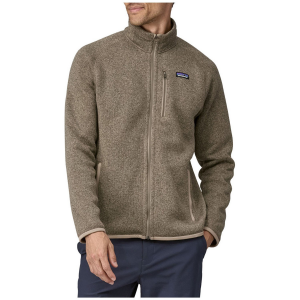
What We Like Designed to last, available in many sizes + versions
What We Don’t Like High price
The only way to improve on Patagonia’s Synchilla fleece jackets was to use recycled material and the Better Sweather has done so since 1993. This fleece also minimizes environmental impacts from dyeing and is Fair Trade Certified. The performance is the same.
The knit face feels similar to knitted wool with softer fleece backing on the inside that is comfortable over bare arms.
It’s really the details that set the Better Sweater apart from other fleece jackets. The collar and pockets are lined with soft jersey fabric and the zipper blocks out wind and won’t scratch the chin when zipped all the way up.
The men’s version has a vertical chest pocket with enough space for a phone. For women there is a handy zipper pocket up high on the left sleeve and dropped hem at the back.
The popularity of the Better Sweater is evident in the range of available styles – shirt, hoodie, vest, kid sizes, gloves, and a beanie.
Best Fleece Jackets for Kids
If you have kids, a fleece jacket is an easy and comfortable way to keep them cozy on cool days. Fleece is cheaper, more durable, and more packable than many other jackets. I have found that fleece can be a better option for kids that refuse to wear a jacket.
Many fleece jackets are available with a quarter-zipper but we do not recommend that for kids. They are more challenging to put on and take off. Plus, kids are generally warm and so a full zip allows for better and more controlled ventilation. Of course, that’s not always true.
The sizing may not be uniform with some brands using “kids sizing” vs boys and girls.
Here are some of the best fleece jackets available for kids. No surprise, some of these have already been mentioned above.
1. Most Durable Fleece Jacket for Kids – Patagonia Better Sweater Jacket For Kids
2. Best Fleece For Kids Who Only Wear Certain Colors – Columbia Benton Springs II (Girls) + Steens Mt II (Boys) Fleece Jacket
3. Most Stylish Fleece For Kids – North Face Glacier Full-Zip Fleece Hoodie
4. Best Lightweight Kids Fleece – Patagonia Kids’ Micro D Snap-T Fleece Jacket
1. Most Durable Fleece Jacket for Kids – Patagonia Better Sweater Jacket

Patagonia products come with a bigger price tag but they are also guaranteed forever. The Better Sweater can be passed down through multiple kids and has a good resale value. Plus, it can be fun to match the kids.
MSRP $99
Warmth Warmer
Fabric 100% Recycled Polyester Fleece
What We Like Soft fabric inside collar, cuffs and pockets
What We Don’t Like Pricey but some colors are discounted
2. Best Fleece For Kids Who Only Wear Certain Colors –
Columbia Benton Springs II (Girls) + Steens Mt II (Boys) Fleece Jacket

Like the adult version, this is the best fleece you can get for the money. It is available in so many different versions so check out all the color, pattern, and hood options for boys and girls. No matter your kids clothing preferences are, there will be something they like.
MSRP $20-$35
Warmth Warmer (250g)
Fabric 100% polyester fleece
What We Like Great price, zipper pockets
What We Don’t Like Boxy cut
GIRLS:
BOYS:
3. Most Stylish Fleece For Kids – North Face Glacier Full-Zip Fleece Hoodie
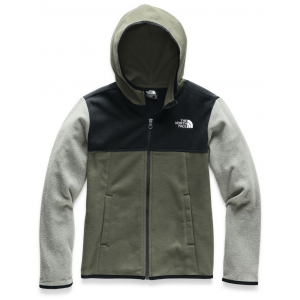
A heavy fleece isn’t always required. This lightweight hoodie has an excellent warmth-to-weight ratio with a design that is similar to the iconic Denali 2. You can also pretend that it’s just a hoodie and not a jacket. Sizing continues up to the teens.
MSRP $35-$65
Warmth Warm (155)
Fabric 100% polyester fleece
What We Like Hood, pill-resistant fabric
What We Don’t Like Price varies by color
Also available in infant and toddler sizes.
4. Best Lightweight Kids Fleece – Patagonia Kids’ Micro D Snap-T Fleece Jacket
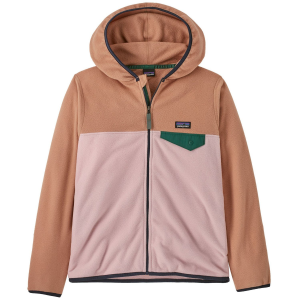
For the really active kids, this is a lightweight performance fleece that is breathable and dries quickly.
MSRP $41-$69
Warmth Warm
Fabric 100% recycled polyester microdenier fleece
What We Like Color combinations, hood
What We Don’t Like Too light for cold weather
The Micro D fabric also comes in a best selling baby bunting and baby/toddler sizes.
FAQ
Which brand has the best fleece?
There is no one best fleece jacket – it depends on what you’re looking for and whether warmth or breathability is more important.
That being said, Patagonia was at the forefront of the fabric and continues to innovate today with increasingly breathable and sustainable fleece fabrics. The North Face is another fleece brand with history. The Denali 2, designed for use on Mount Everest, was released in 1986 and updated in the 90s. The plush fabric with nylon panels is an iconic design that is stille popular today.
There are plenty newer entries to the fleece game, mostly focusing on types of grid fleece. Find the one that fits your body and budget.
What is the warmest fleece to buy?
The heavier the fleece, the warmer it will be. Some are listed as 300-weight or heavyweight. Other than that, just give it a feel. Some fleece, especially with a high pile like sherpa fleece, can be as thick as 1/4”.
The aforementioned Denali 2 is one of the warmest fleeces out there, at above 300-weight.
Which is warmer fleece or puffer?
This is more of a question of seasons. Down is ideal in winter while fleece excels in the shoulder seasons. They can also be used together.
No doubt, down will keep you warmer, especially with heavy fill like 400 and up. However, down jackets are pricey, delicate, and ineffective when wet.
Fleece is available at a wide range of price points, durable, and naturally repels water. Fleece is also soft to the touch, breathable, and machine washable.
Is fleece windproof?
Fleece is not completely windproof. A thicker jacket will block some wind but not all.
It is possible to make fleece windproof but that also makes it less breathable A breathable fleece backed up by a wind jacket offers superior performance to a windproof fleece. Wind jackets are very light and packable.
Does fleece pill?
All knit garments are prone to pilling, although some fleece fabrics claim to resist pills. It’s is an easy fix with a lint remover or fabric shaver.
Does fleece shed microplastics?
Microplastics are tiny pieces of plastic, finer than a strand of hair. There is still a lot that is not know about microplastics but it is known that they contribute to global plastic pollution and could harm both marine organisms and people who eat them.
Fleece is one of the top domestic sources of microplastics, moving from laundry into water.
Does this mean you shouldn’t wear fleece?
I say no, with a but.
First, fleece is not the only fabric that sheds plastic. All synthetic fabrics, including polyester, nylon, acrylic, rayon, and spandex all contribute to the issue.
Second, the majority of microplastics, an estimated 65%, are produced by industry. Corporations often try to push environmental responsibility on consumers when they are the vast majority of the problem. This issue needs to be addressed from the production side as well as consumer use. Microplastics could also be managed along with the water supply.
When I first learned of microfibers, I thought Patagonia would stop making fleece if it was that big of a problem. That was many years ago and that hasn’t happened.
However, Patagonia, and others, are committed to making changes. A study commissioned by Patagonia found that higher quality synthetics shed less micro plastic than low-quality products and recycled polyester sheds less than new polyester.
Learning this, Patagonia makes 91% of synthetics with recycled plastic as well as making durable, long-lasting products. They do offer a lifetime warranty after all.
Textile producers are also looking for more ways to make fleece to minimize this issue, like the non-brushed fabric and recycled Adidas Flooce, which sheds fewer microfibers.
What can I do about micropastics?
Obviously you can do nothing but if you want to do something, here are 3 ways to reduce micro plastics.
1. Buy a good quality fleece made with/of recycled plastic. Good quality doesn’t have to be expensive.
2. Use a front-load washing machine. Top loaders release higher levels of micro plastics.
3. Add a microfiber filter or bag to laundry.